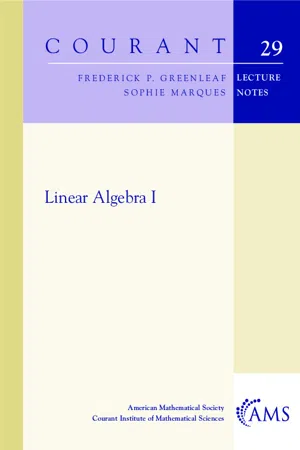
- English
- PDF
- Available on iOS & Android
Linear Algebra I
About this book
This book is the first of two volumes on linear algebra for graduate students in mathematics, the sciences, and economics, who have: a prior undergraduate course in the subject; a basic understanding of matrix algebra; and some proficiency with mathematical proofs. Proofs are emphasized and the overall objective is to understand the structure of linear operators as the key to solving problems in which they arise.This first volume re-examines basic notions of linear algebra: vector spaces, linear operators, duality, determinants, diagonalization, and inner product spaces, giving an overview of linear algebra with sufficient mathematical precision for advanced use of the subject. This book provides a nice and varied selection of exercises; examples are well-crafted and provide a clear understanding of the methods involved. New notions are well motivated and interdisciplinary connections are often provided, to give a more intuitive and complete vision of linear algebra. Computational aspects are fully covered, but the study of linear operators remains the focus of study in this book.
Frequently asked questions
- Essential is ideal for learners and professionals who enjoy exploring a wide range of subjects. Access the Essential Library with 800,000+ trusted titles and best-sellers across business, personal growth, and the humanities. Includes unlimited reading time and Standard Read Aloud voice.
- Complete: Perfect for advanced learners and researchers needing full, unrestricted access. Unlock 1.4M+ books across hundreds of subjects, including academic and specialized titles. The Complete Plan also includes advanced features like Premium Read Aloud and Research Assistant.
Please note we cannot support devices running on iOS 13 and Android 7 or earlier. Learn more about using the app.
Information
Table of contents
- Cover
- Title page
- Contents
- Preface
- Chapter 1. Vector Spaces over a Field KK
- Chapter 2. Linear Operators 𝐓:𝐕→𝐖
- Chapter 3. Duality and the Dual Space symbfit {𝑉*}
- Chapter 4. Determinants
- Chapter 5. The Diagonalization Problem
- Chapter 6. Inner Product Spaces
- Index
- Back Cover